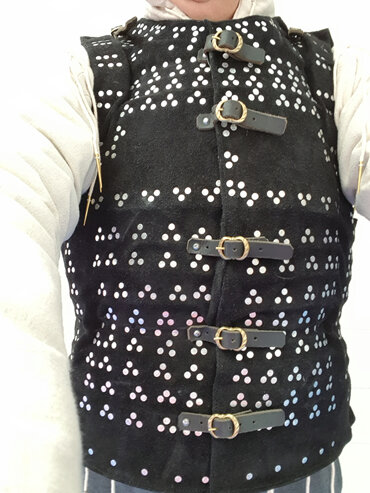
This type of armour construction formed a very solid defence. It could made made fairly easily with whatever materials were available and in the medieval period was a widely used alternative to the more expensive full metal plate armour. It was far cheaper and easier to make than both plate and maille armour with many of the advantages of both. Garments made in this manner were comfortable and unlike maille armour it provided good protection against blunt impacts and period illustrations show foot soldiers also wearing brigandine type armour over maille haubergeons or hauberks.
The Greek Linothorax Cuirass is a andcrafted armor inspired by ancient warriors of Greece and Macedonia.
This 14th century Splint Arm Harness provides exceptional protection and mobility and is crafted from genuine leather and steel.
Experience unmatched safety with our 14th century Splint Leg Harness, designed for the best protection in historical reenactments
Step into the world of medieval warfare with the 14th Century Kusnacht Brigandine. Inspired by the legendary Kusnacht Brigandine.
This brigandine takes inspiration from a remarkable Sleeping Guard statue dating back to 1270, currently residing in the Provinzial Museum, Hanover, Germany.
This high quality armour is a fully functional replica of the Leeds Brigandine dated 1470. It is suitable for most forms of medieval combat with 150 overlapping steel plates designed to spread the shock of impact across a wide area.
9th - 11th Century Eastern Europen Lamellar Body and Shoulder armour made from overalapping steel plates that have been painstakingly laced together with leather thongs.
Cardiophylax armour for the upper chest wron by light infantry from the Iberian peninsula.
Fully functional Viking split greaves made from 1.6mm mild steel.
Bazubands first appeared in Asia Minor to protect the lower arm from Elbow to Wrist. They proved to be very functional and practical so were also adopted by warriors throughout Europe and the near East.
14th -16th century leather brigandine gorget.
Rus/Viking Lamillar shoulder armour (pair) made from 7 cm mild steel plates in 16 guage steel and 7 cm. 33 cm by 16 cm.
A pair of sturdy leather vambaces to protect the forearm.
These lamellar plates are 7.2 long by 2 cm wide. They come in packets of 100 for plain steel or blackened steel plates and in packets of 20 for brass plates.
Packet of 100 9.5 cm by 2.5 cm lamellar plates based on archeological find near Ketch, Crimera.
Lamillar armour was made up of small metal, wood, leather, horn or bone plates laced together to create a cheap but effective rigid defence typically to protect the torso and upper limbs.